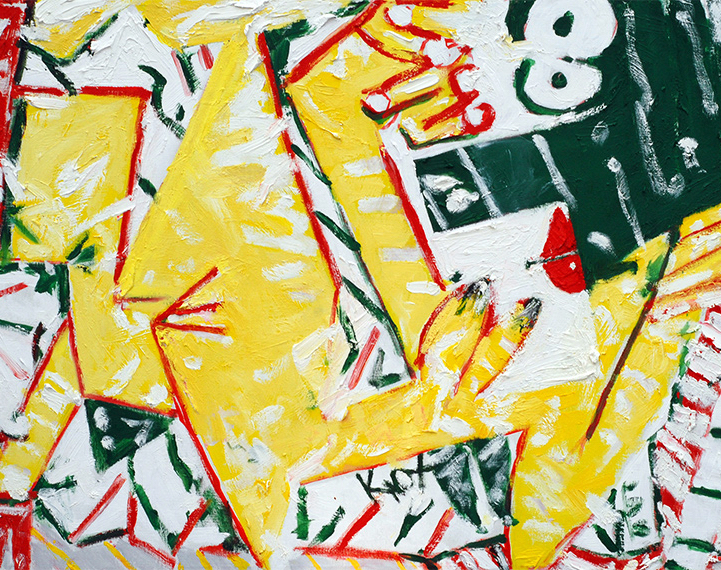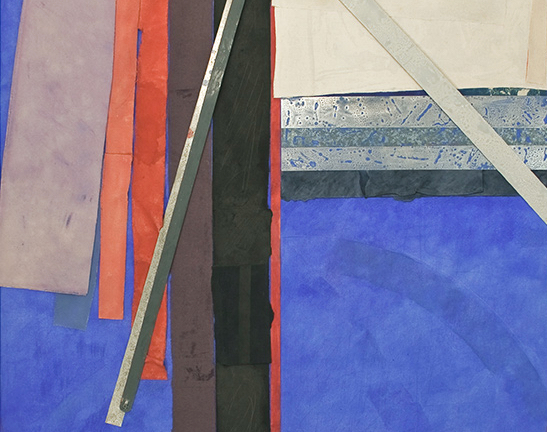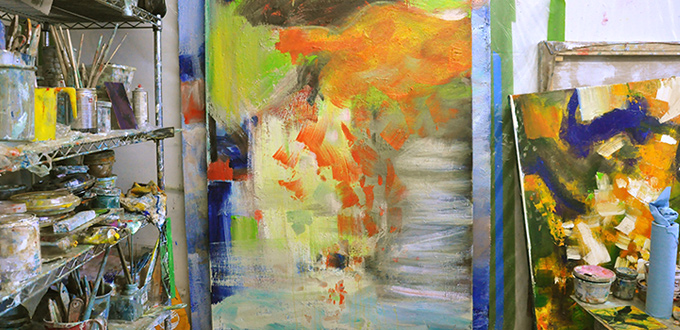Ira Goldberg: You mentioned to me that you attended Robert Beverly Hale’s anatomy lectures. What year was that?
Paul Resika: It was when I came back from Europe in 1954. It was much too late for me to be learning anatomy.
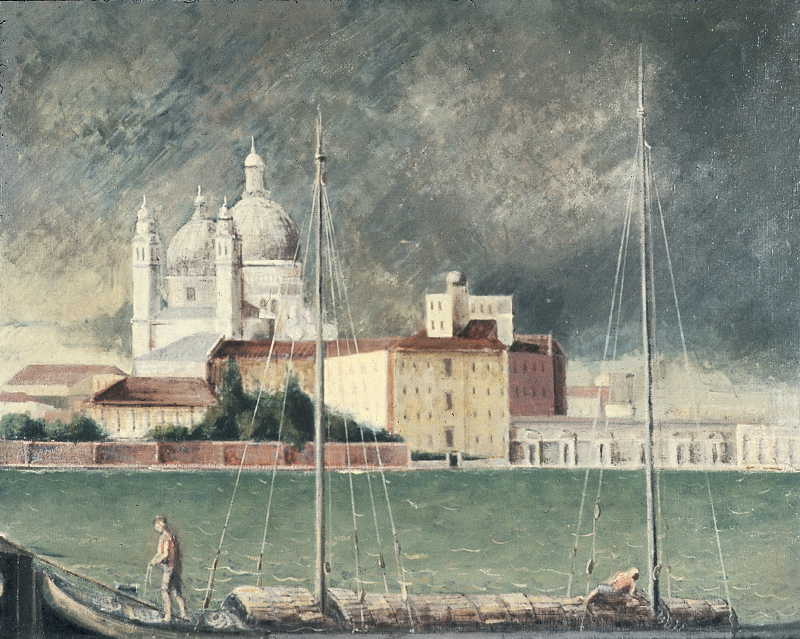
How long were you in Europe?
I was in Paris in 1950. Around Christmas time I went to Venice and stayed two years, and Rome for a year.
At that point, were you already on the path of art?
I was already a painter; I was always a painter.
How did that come about?
I had an uncle who was a painter. His name was Harry Shapiro. My whole family lived on Convent Avenue on 140th Street. There were a group of painters whom he knew; some were his friends, some were his enemies. He was friends with Sol Wilson, Joseph Kaplan, and Remo Farruggio. Another who lived there was Naum Tchacbasov. He was a very gifted painter and a very shrewd man. To this day, I can still remember a grand landscape by him called Xanadu, which I saw at the ACA gallery on 57th Street. I also remember a painting of a Madonna and child in gas masks—this was around 1940.
So when did your art studies begin?
I was about twelve and my mother arranged for me to study with Sol Wilson in his studio on 16th Street. In that same building Moses Soyer, James Lechay, and Philip Reisman had studios. Wilson was part of a group of landscape painters who loved Ryder and Rouault. Also part of the group were Jean Liberte, Henry Mattson, Joseph De Martini—who was the most successful, and later became a fine “metaphysical painter.” At eight or nine years old, I was sent to the children’s class at the American Artists School— the left wing school on 14th Street where, I think, Diego Rivera taught.
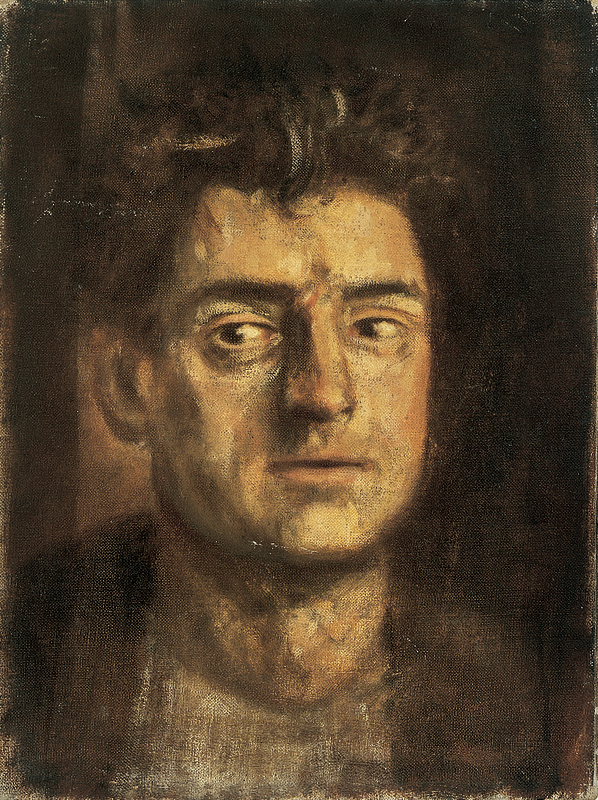
They were kind of the League’s rival at the time.
It might have had to do with politics.
How would politics have gotten into that school?
At that time politics were important in my upbringing, and in the art world, too. Even Stuart Davis wasted years of his life as the head of the Artists’ Union.
So, after you studied with Sol Wilson, what was the next significant phase of your life?
Hans Hofmann was the second main part of my life in art. I was seventeen when I entered his class on 8th Street.
Tell me about your time there.
I began my studies there in 1945, and since I was still in high school I took the night class for my first year. It was an academy, you might say. Hofmann was the only teacher. It was before the G.I. Bill, and the school was small. There were maybe seven or eight students at night and six or seven during the day. It was sort of a secret, and a great school. During the summer I wrote Hofmann and asked to be the monitor on scholarship; I became the morning and afternoon monitor in 1946-47. Once the G.I. Bill came, that September, the school was much different. Instead of six or eight students, there were fifty students. About thirty actually stayed in the school, and another ten or twenty who just signed up to get their benefits. My duties were unlocking the door in the morning, sweeping up, putting out the easels and horses (we used upside down folding chairs to hold the drawing boards), and posing the model. And for the first time a roll had to be called.
Did Hofmann give you assignments?
No, but the model posed all week: a morning pose, an afternoon pose, and an evening pose. At the Hofmann School there was always a model. We all drew from the model on the same size paper, which was about 24 x 18 inches, and on the same size drawing board. And we all drew the same way. In my class were a couple of people who had been there for years, others who had just begun; and when Bennington College let out for the winter period, some beautiful girls would join the class. When I first entered the school, I got the idea of how to draw from Bill Freed and Nevis Billmeyer, who were there. I still have some of my drawings from that the first year. One of them is in the collection of the Metropolitan Museum.
When you say he ran it like an academy, what does that mean?
It was like an academy because all of the students drew the same way. It had nothing to do with self-expression. It wasn’t about doing anything your own way. He was trying to show you the principles of picture making. That was it. These were his ideas, which he began to formulate in Munich in 1915. This certain way of teaching….
Can you describe it?
He would come in on Tuesdays and Fridays. He’d choose one or two students for criticism. He would demonstrate on the student’s drawing with diagrams and corrections. The serious people in the room would stop working and congregate behind him. Much has been written about his method and aims, but Vaclav Vytlacil, who was perhaps Hofmann’s greatest disciple, described it in a wonderful way.
He said when drawing a standing figure, “Hofmann took away the wings.”
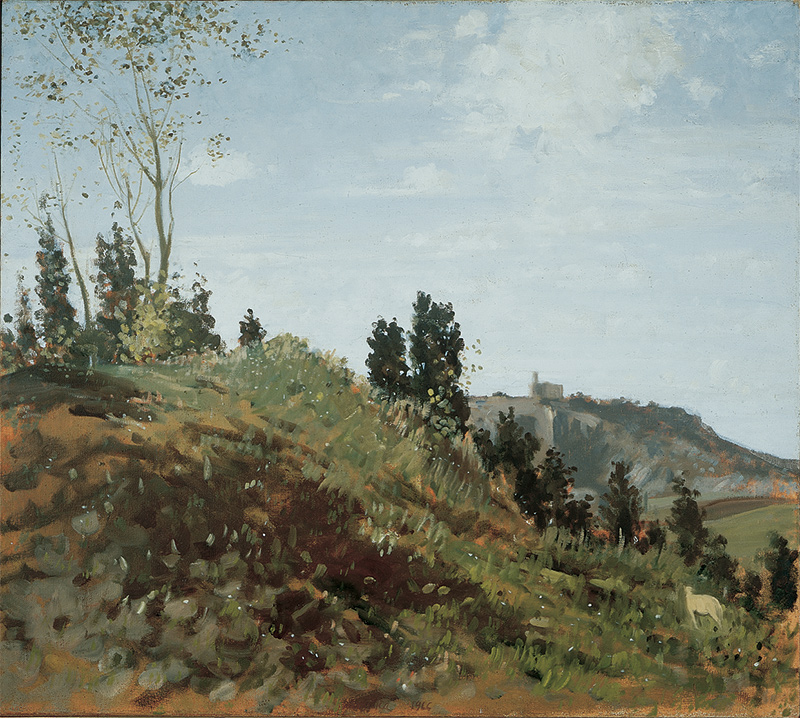
Did that mean you couldn’t leave those spaces empty?
It meant that there was no dead space. Everything was alive. You were not drawing a figure in an empty space; you were creating a full, artistic space. You know, the academy figures by Gérôme or even by Cézanne are all standing there with the wings…
So, it became negative space?
That famous phrase, negative space. Yes, perhaps that’s where it comes from, but by that Hofmann didn’t mean “flat shapes.” He took away the dead (empty or flat) space.
His other famous phrase was push-pull, yes?
Right, and that had to do with overlapping planes, depth and flatness, in other words plasticity. Vyt would simply say, “Hofmann took away the wings,” which is more poetic. With Hofmann, you had to draw forces; there were no things. Everything was about relationships. Hofmann would insist on these forces. I argued—after two years of study—“Well, what do you mean? How do you draw the foot?” He just laughed and talked about constructing the plastic quality and not drawing anatomy. I could see that Hofmann knew anatomy, and brilliantly. I could see that he was a real master of everything. Michelangelo, whom he always spoke of, was his main example for drawing. Always Michelangelo, because he had that power, the mass, force, volume, plasticity, and clarity of planes.
Was he trying to tell you that you didn’t need to know anatomy in order to understand that?
He was definitely telling me that.

But you didn’t buy into it?
I was a kid. How could I understand it? I’m one of those artists that wants to be able to do what he can’t do.
Do you still feel that you just need to understand the plastic form?
He was absolutely right. I was completely cockeyed.
This is a long-standing argument whether anatomy should come first.
Regarding anatomy, Edwin Dickinson said, “Anatomy: when you’re young enough to think you need it and not yet old enough to know it won’t do.” In other words, you’ve got to be young and learn it like a language. Maybe I didn’t have the talent for it. I think it was just too late for me. I was already on my way.
Some don’t start their artistic lives until their twenties. I’m sure those people studied with the understanding that anatomy was a foundation. Who would you say achieved greatness without first knowing anatomy?
Piero della Francesca. He came before anatomy. Cimabue, Giotto. None of them had academic training.
It’s an ongoing debate about the foundations of cognition. The struggle is to learn it, and then get rid of it.
There are whole schools of art, like the modern English school, based on measuring and copying. Everybody thinks it’s looking at the object, but Hofmann was showing you that it was about looking for relationships.
So, why bother having the model?
You need something as a point of reference. After all, space is near and far.
After studying with Hofmann, what was your next pivotal moment?
I was trying to paint in a more figurative way. I guess you’d say like Beckmann or Bonnard. There was a great Bonnard show around 1948 at the Museum of Modern Art that affected us all in the Hofmann school. After that, many of us went back to nature. And many refused “abstraction” as the answer. Those with more culture didn’t have a problem between figure and abstraction. Torres-Garcia’s school, for example.
My first group show was with Hofmann students, at the Jacques Seligmann Gallery on 57th Street. New Provincetown ‘47 was chosen by Hofmann, Adolph Gottlieb, and Boris Margo. Most of us were painting from nature: Paul Georges, Wolf Kahn, and I. Bob Goodenough and Larry Rivers were abstract. Leatrice Rose—I don’t remember what she was painting in those days. We were all in that show, and it was a big event in our young lives. Clement Greenberg even wrote about it. You might say we were on our way. A year later at the George Dix Gallery on Madison Avenue I had my first one-man exhibition, which was mostly influenced by Picasso, Matisse, and Bonnard.
Did you feel that art at that time was becoming so intellectualized that Bonnard offered a sense of romanticism?
We felt that very strongly. We also thought that abstraction was not the way, even though we were in the great days of abstract expressionism. By the way, that term was never used at the time; it came much later from critics and art historians. We were against it, and we were the Hofmann kids.
Did you feel a sense of conflict?
Oh, yes. We felt we were the ones doing something, but the others were about to become famous. Still, when de Kooning had his first show in 1948 we all thought it was the greatest. The Black and White pictures—I thought it was great, and still do. It was in a little gallery where the door was always open and there was often no attendant. Interesting, some still wouldn’t even walk in; the old-timers were so mad at Hofmann and de Kooning.
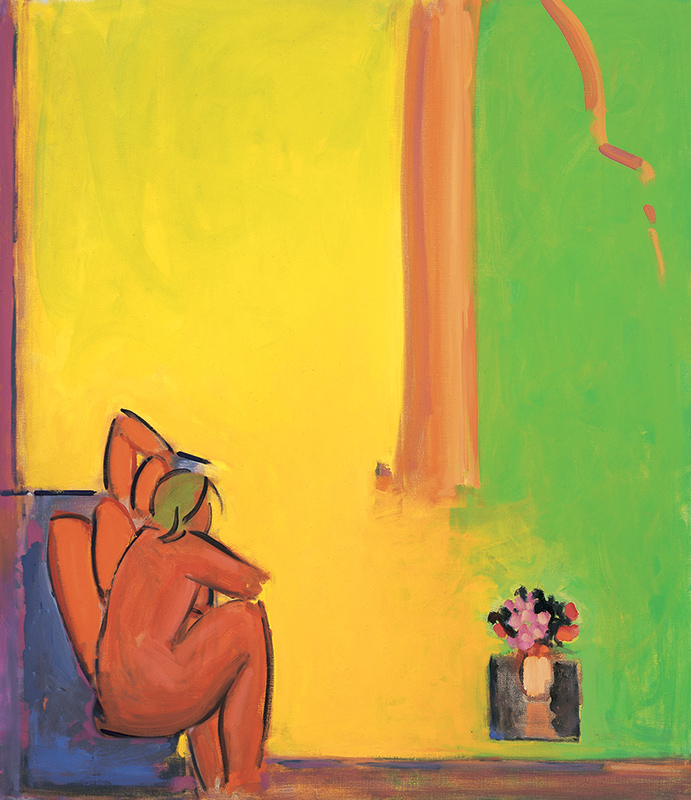
But wasn’t Picasso the dominant force in art then?
Yes, but did he influence the Art Students League? Not too much.
So, in 1950, you went to Paris?I was twenty-two years old and I went to Paris like everybody did— to find out what art is. I intended to go to the Beaux-Arts, but wasn’t on time for the examination. So, I went to the Académie de la Grande Chaumière, which is where everyone went to draw. Some of my old friends lived in Paris: Reginald Pollock and Burt Hasen. They helped me get started. I was there from about spring until Christmas time. I had a little studio on the Rue des Suisse. (The Israeli painter Steimatzky was a friend and neighbor.) The girl I married was a dancer, and she got a job in a nightclub in Rome. So, I went to Rome. In Rome I met an American painter, Peter Ruta. He told me that he just left his place in Venice—a palace that cost $18 a month. He said, “That’s where you should go.”
So you went to Venice and got a room at that same place?
Not just a room, but part of a whole floor, with beautiful rooms, looking out across at the Salute. I lived there for two years. I had $100 a month from my father. In 1950, that went very far. There were very few Americans in Venice at that time, and it was a small world, very provincial. In those days, there was no tourism in Venice in the winter. I used to be in the Piazza San Marco with not one person in it. Can you imagine that?
Did you paint there?
I would paint out of my window. I was trying to paint like the Venetians, which meant I had to paint figures as well. I would draw the people in the morning and the masters in the academy in the afternoon. Bliss! The painter Edward Melcarth moved in next door. I’d seen his show at Durlacher Brothers before I left New York and was very impressed. They were big pictures of people in action. A little like Thomas Hart Benton, but more Venetian, more free, and not of American scenes.
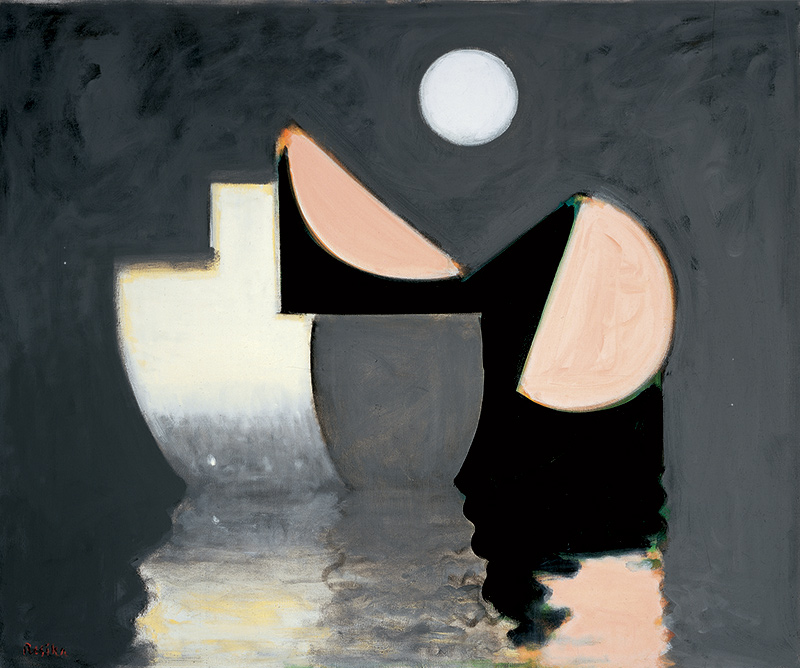
What were they depicting?
One was called The Sleepers, which I remember as a masterpiece. It was of people asleep at the station, maybe in Grand Central, with newspapers covering them, but painted in a full, rich way. Another was of a strike: men with placards wearing checkered shirts and moving like Tintorettos. You can recognize those paintings because they all look like West Side Story. Now they’re in the Forbes Collection downtown.
It sounds a little bit like Reginald Marsh.
Very much like Marsh, but more like Tiepolo and Veronese.
Did he have that color?
Not like Marsh’s grey and grisaille. It was full. It was corny. For about a year, I worked as Melcarth’s assistant. Meanwhile, I was in my own studio next door painting my own versions, which were getting more and more like his, more and more Venetian, which I wanted. He and I were in a show in Venice together that was written up in Time magazine. Melcarth was a great influence on me. I was also carrying influences of others, like Hofmann and Tintoretto. I was carrying everything, I thought I was finished with Hofmann—it seemed to be a lost cause.
Were Hofmann and Tintoretto an easy fit?
It is an easy fit now, but it wasn’t then. The Venetians were not part of the modern canon. Piero, Caravaggio—they were the precursors.
When did you decide to go back to New York?
Before I returned, I lived in Rome for a year. There I painted the same kind of pictures that I had been painting in Venice. I guess there was no more money coming in, whatever the reason, it was time to go back. I never thought I’d leave Venice, and then Rome. I never thought I would leave Italy, such a dream life. When I came back to New York, in 1954, the first studio I had was in the Van Dyke Studios on Eighth Avenue. It was near the League, and I began going to a sketch class there.
You said you took Hale’s lecture series.
I went to his lecture series because it brought me up to date on certain things I wanted. But I had already studied anatomy with Phillip Reisman before I went to Europe. Reisman was a great anatomist. He and Marsh were both great anatomists; they drew like Fragonard. Reisman tried to be a social realist when he painted, so it got dumpy. He made his people dumpy, though he was really thinking like Fragonard. He’d sit down and draw like an angel next to your drawing. I never did take Hale’s class, only his lecture series.
Isn’t it ironic that so many people, after having learned anatomy and worked their way through it, come to the conclusion that they should never have studied it to begin with. Do you think one is better off having learned it?
Let me say this: it is a very complicated thing. After all, Léger would say, “The object is the only thing that matters.” And Hofmann would say, “The relationship is the only thing that matters.” Now, there is no anatomy in Leger …
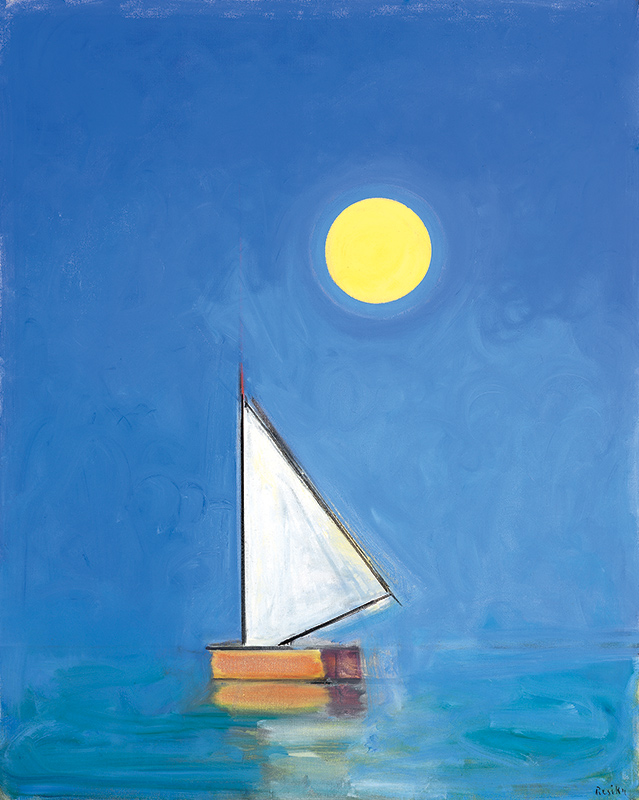
No, but there is a strong structure.
Yes, there is powerful form: an automobile or a clock, birds, clouds, animals—all objects, but no anatomical structure.
How did you get through the struggle between plastic and naturalistic?
Slowly but surely. I began to work outdoors, painting landscape in 1958. All of a sudden my work had a freshness, an immediacy. I was looking, and I was getting out of myself. It was getting fresh— that’s when I became a modern painter again.
Did you feel that once you found that and felt totally connected with it, you were free from that point on?
No, it took many years. Many years of coming indoors in the winter and trying to do it over again and make it into something solid. It was this crazy thing, but bit by bit it got freer. Finally, after forty years or more, I hardly paint from nature at all.
When did you first go to Provincetown?
I first went in the Hofmann days. I didn’t really study with him then, but I was still part of his world. It was 1947. After that I didn’t go back, except to bury Jan Muller. I didn’t go back and wasn’t part of the Provincetown world until after I met my wife, who is from that area. I met her through Sidney Simon in 1963.
When did you start to become known?
In 1965 I began to exhibit landscape paintings at the Peridot Gallery.

Whose work were you looking at?
Cézanne. Cézanne. Cézanne. And Corot was my god. I lived with Tintoretto for many years. I was with Corot for many, many years. I used to say I was married to Corot. For about fifteen years, he was the greatest thing in the world to me. I thought I knew every thing about Corot. I even went to Europe, to Volterra, to paint in the same places (at the same age!). He’s one of the greatest artists who had ever lived, but I don’t go into the Corot room at the Met as I once did. I used to go look and draw from Corot and Poussin. And then Claude.
Did you see the recent show at the Met, Poussin and Nature: Arcadian Visions?
That was a beautiful and perfect show. I went the first day, and was laid low by it. I was in heaven. I didn’t know what to do. In the last room I thought, “If I died now, I’m where I’m want to be … with the last Poussin landscapes!
But the greatest show I’ve seen recently was in Boston, the Venetian exhibition, Titian, Tintoretto, Veronese: Rivals in Renaissance at the Museum of Fine Arts, Boston. That exhibition brought my whole life back to me. It’s the highest art. It’s like the Elgin Marbles with color and movement. After that, we’re all pygmies.
How do you deal with that?
I don’t know. I’m dealing with it today, a bit diminished but determined. It’s driven me back to the easel. Now I have a sore arm. How does one deal with it?
You bring up an interesting point: what it feels like to encounter such greatness, and then feel like we’re pygmies by comparison.
After the Venetian show, I went to look at Cézanne and the Renoir, both of whom I adore. They are two of the greatest artists that ever lived: these pillars of modern art, I couldn’t even look at them. (Perhaps the large Corot of Virgil is an exception!) That Venetian show had such Titians, Veroneses, and Tintorettos, including many I have never seen because they came from churches in remote places. There were beautiful surprises: Andromeda and St. Jerome by Veronese, next to the great Titian of St. Jerome, which is the finest of all. Of course, Titian is the best there ever was. And everyone knows that; every painter has always said it.
No doubt about it.
When I came back from Italy, I was walking on the beach with Clem Greenberg, out on Long Island. And he said, “Of course, Titian is better than anyone else.” I said, “Clem, you knew that all this time?”
There is no secret about that. But then, to discover that Veronese and Tintoretto were not behind Titian was surprising. I never thought that.
After you saw the show, you came back to the studio and painted?
Yes—that’s why my arm is sore!
Do you think art has a future?
Well, we’re all painting. We in New York have had great painters: de Kooning, Marin, Stuart Davis, Gorky, Hartley. Let’s not forget Louis Eilshemius, whom Matisse said was our best. And so there is hope. Just yesterday, I saw a beautiful memorial show for Charles Seliger and a ninety-fifth birthday exhibition for Jack Levine. Lennart Anderson is still painting beautiful pictures and I’m still going.
So you’re not going to stop painting. Your arm is going to get better, and you’ll continue.
I don’t know which of the Italian painters said, I, also, am a painter—“Anch’ io son pittore.”
This interview was originally published in the Spring 2010 print issue of LINEA.


